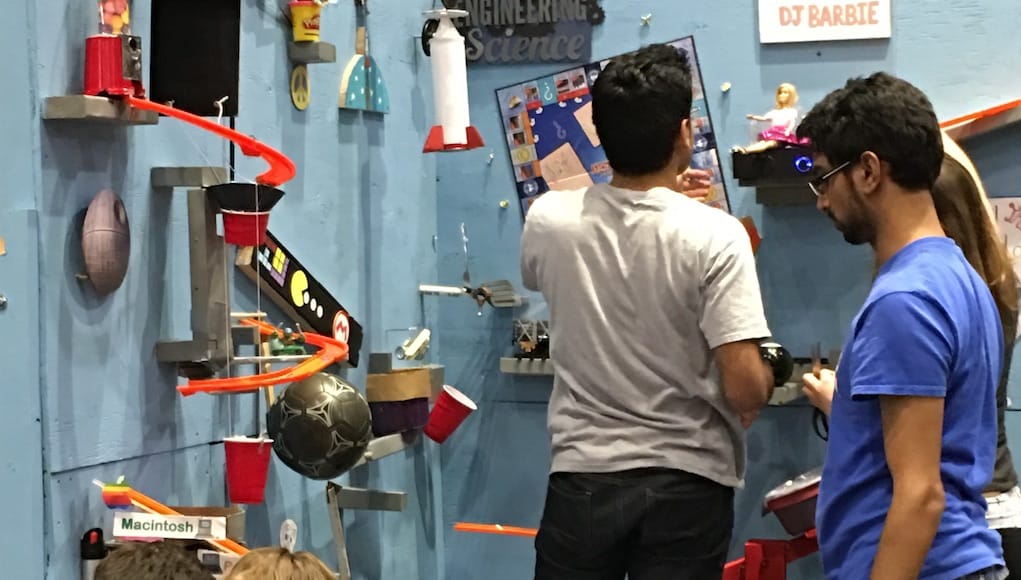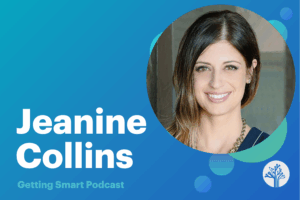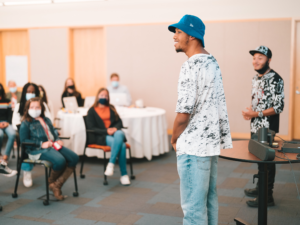Rube Goldberg Machine Contest Puts Students’ Creative Minds to Work

By Christa R. James-Byrnes
As a Professor of Engineering at a small two-year campus in the University of Wisconsin System, showing entry level students how fun engineering can be has always been a goal of mine. Our campus is one of a group of 13 two-year colleges that offer general education courses for students, of which we are the 9th largest transfer major. We serve about 900 aspiring engineering students, but this is not about the 900—this story is about the Fantastic 4.
In 2016, four of our students took on the arduous task of creating a Rube Goldberg Machine™. Rube Goldberg was a Pulitzer-winning cartoonist; he created cartoons that made the simplest task difficult and complicated. He always repurposed items and used them in the most unique and interesting way. Every year, there are Rube Goldberg competitions all over the country (more information on this year’s competition below), and teams build complicated machines to do the simplest of tasks. Competitions are held at all levels, from middle school to high school to the collegiate level.
Our Fantastic 4 consisted of Dru Galetka (Captain), Mechanical Engineering; Matt Dentinger, Electrical Engineering; Jacob Sazinger, Plastics Engineering; and Zach Metza, Engineering Technology. They built their machine in a classroom, utilizing the theatre scene shop, a few hand tools and their ingenuity. They worked tirelessly for months on end, sticking with it to build their Rube Goldberg Machine. The task was to open an umbrella, and their machine did that in the most interesting way. These four young men beat the odds—they competed at the National Collegiate Rube Goldberg Competition and won!

As their professor and advisor, I acted as their coordinator and took a very hands-off approach. This was their machine, their story, their work and their win! Of course, I provided constructive criticism and threw ideas at them; but in the end, it was their decision on how the machine was constructed and the story they wanted to tell. They applied lessons learned from my engineering classes and their own experiences working on the farm, on cars, and at jobs to build a prize-winning machine. They used all the skills that an engineer needs: creative problem solving, communication, teamwork, leadership and, above all, tenacity.
As educators, we need to remember that we teach in the classroom, but we also need to provide opportunities for students beyond the classroom.
This year, the tradition continues as participants are to complete the task of creating a machine made out of common everyday objects capable of applying a BAND-AID bandage. The overarching goal is to inspire students to develop the resiliency to achieve the task or goal at hand. That’s exactly what the Fantastic 4 aimed to do (keep on creating, inspiring and doing what they love), and it was a major contributing factor to their success.
The contest is rooted in getting kids to disconnect from their laptops and tablets by engaging them in team-centric social activities that use all aspects of the education system. I have taught in higher education for over 30 years, and I can say without a doubt that the Rube Goldberg competition is one of the most difficult projects I do; but it is by far the most rewarding, too. I would encourage any educator regardless of discipline to try this—you will not be disappointed!
The contest has both live and online divisions for a variety of age groups, so students all over the world can compete. For the live version of the contest, students compete first in a local competition, working their way to the Finals at the Center of Science and Industry (COSI) in Columbus, Ohio on March 24, 2017.
For those students interested in participating in the online division of the contest, the deadline for entry is March 31, 2017.
For those who would like to enter or host a Rube Goldberg Machine Contest, I encourage you to visit https://www.rubegoldberg.com/contests/ to learn more. You can also watch this video from Wisconsin Public Television.
I hope you will consider entering this year’s challenge—I welcome the competition! But if not, these ideas can still go a long way in your classroom.
For more, see:
- Your Students can be “Makers”: 16 Projects Invented by Teachers
- 3 Tips for Building a STEM Classroom Makerspace
- The Makings of a Makerspace: Three Examples
Christa R. James-Byrnes, Ph.D., is a Professor of Engineering at UW-Colleges.
Stay in-the-know with all things EdTech and innovations in learning by signing up to receive the weekly Smart Update.







0 Comments
Leave a Comment
Your email address will not be published. All fields are required.